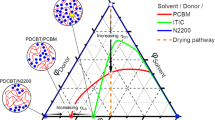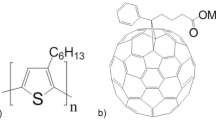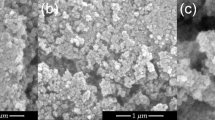Abstract
Polymer layers can exhibit significantly improved performances if they possess a multicomponent phase-separated morphology. We present two approaches to control the dimensions of phase separation in thin polymer-blend layers; both rely on polymer nanospheres prepared by the miniemulsion process. In the first approach, heterophase solid layers are prepared from an aqueous dispersion containing nanoparticles of two polymers, whereas in the second approach, both polymers are already contained in each individual nanoparticle. In both cases, the upper limit for the dimension of phase separation is determined by the size of the individual nanoparticles, which can be adjusted down to a few tens of nanometres. We also show that the efficiencies of solar cells using two-component particles are comparable to those of devices prepared from solution at comparable illumination conditions, and that they are not affected by the choice of solvent used in the miniemulsion process.
This is a preview of subscription content, access via your institution
Access options
Subscribe to this journal
Receive 12 print issues and online access
$259.00 per year
only $21.58 per issue
Buy this article
- Purchase on Springer Link
- Instant access to full article PDF
Prices may be subject to local taxes which are calculated during checkout





Similar content being viewed by others
References
Halls, J.J.M. et al. Efficient photodiodes from interpenetrating polymer networks. Nature 376, 498–500 ( 1995).
Yu, G., Gao, J., Hummelen, J.C., Wudl, F. & Heeger, A.J. Polymer photovoltaic cells — enhanced efficiencies via a network of internal donor-acceptor heterojunctions. Science 270, 1789–1791 ( 1995).
Brabec, C.J., Sariciftci, N.S. & Hummelen, J.C. Plastic solar cells. Adv. Funct. Mater. 11, 15–26 ( 2001).
Jones, R.A.L., Norton, L.J., Kramer, E.J., Bates, F.S. & Wiltzius, P. Surface-directed spinodal decomposition. Phys. Rev. Lett. 66, 1326–1329 ( 1991).
Böltau, M., Walheim, S., Mlynek, J., Krausch, G. & Steiner, U. Surface-induced structure formation of polymer blends on patterned substrates. Nature 391, 877–879 ( 1998).
Krausch, G. Surface-induced self-assembly in thin polymer films. Mater. Sci. Eng. R 14, 1–94 ( 1995).
Walheim, S., Böltau, M., Mlynek, J., Krausch, G. & Steiner, U. Structure formation via polymer demixing in spin-cast films. Macromolecules 30, 4995–5003 ( 1997).
Müller-Buschbaum, P., Gutmann, J.S. & Stamm, M. Influence of blend composition on phase separation and dewetting of thin polymer blend films. Macromolecules 33, 4886–4895 ( 2000).
Halls, J.J.M. et al. Photodiodes based on polyfluorene composites: Influence of morphology. Adv. Mater. 12, 498–502 ( 2000).
Shaheen, S.E. et al. 2.5% efficient organic plastic solar cells. Appl. Phys. Lett. 78, 841–843 ( 2001).
Hamley, I.W. The Physics of Copolymers (Oxford Univ. Press, New York, 1998).
Binder, K. in Polymers in Confined Environments (ed. Granick, S.) 1–89 (Advances in Polymer Science Series 138, Springer, Berlin, 1999).
Schmitt, C., Nothofer, H.-G., Falcou, A. & Scherf, U. Conjugated polyfluorene/polyaniline block copolymers. Macromol. Rapid. Commun. 22, 624–628 ( 2001).
Johansson, D.M., Theander, M., Granlund, T., Inganäs, O. & Anderson, M.R. Synthesis and characterization of polyfluorenes with light-emitting segments. Macromolecules 34, 1981–1986 ( 2001).
Macosko, C.W. et al. Compatibilizers for melt blending: Premade block copolymers. Macromolecules 29, 5590–5598 ( 1996).
Hillmyer, M.A., Maurer, W.W., Lodge, T.P., Bates, F.S. & Almdal, K. Polymeric co-continuous microemulsions in ternary homopolymer/block copolmer blends. J. Phys. Chem. B 103, 4814–4824 ( 1999).
Pernot, H., Baumert, M., Court, F. & Leibler, L. Design and properties of co-continuous nanostructured polymers by reactive blending. Nature Mater. 1, 54–58 ( 2002).
Landfester, K. et al. Semiconducting polymer nanospheres in aqueous dispersion prepared by a miniemulsion process. Adv. Mater. 14, 651–655 ( 2002).
Piok, T. et al. Organic light-emitting devices fabricated from semiconducting nanospheres. Adv. Mater. (in the press).
Yan, M., Rothberg, L.J., Papadimitrakopoulos, F., Galvin, M.E. & Miller, T.M. Defect quenching of conjugated polymer luminescence. Phys. Rev. Lett. 73, 744–747 ( 1994).
Bliznyuk, V.N. et al. Electrical and photoinduced degradation of polyfluorene based films and light-emitting devices. Macromolecules 32, 361–369 ( 1999).
Grell, M., Bradley, D.D.C., Ungar, G., Hill, J. & Whitehead, K.S. Interplay of physical structure and photophysics for a liquid crystalline polyfluorene. Macromolecules 32, 5810–5817 ( 1999).
Scherf, U. & Müllen, K. Polyarylenes and poly(arylenevinylenes). 7. A soluble ladder polymer via bridging of functionalized poly(para-phenylene)-precursors. Macromol. Chem. Rapid Commun. 12, 489–497 ( 1991).
Scherf, U. & List, E.J.W. Semiconducting polyfluorenes: Towards reliable structure-property relationships. Adv. Mater. 14, 477–487 ( 2002).
Zhao, Y., Levesque, J., Roberge, P.C. & Prudhomme, R.E. A study of polymer blends by nonradiative energy-transfer fluorescence spectroscopy. J. Polym. Sci. Polym. Phys. 27, 1955–1970 ( 1989).
Jiang, M., Chen, W.J. & Yu, T.Y. Controllable specific interactions and miscibility in polymer blends. 3. Nonradiative energy-transfer fluorescence studies. Polymer 32, 984–989 ( 1991).
Arias, A.C. et al. Photovoltaic performance and morphology of polyfluorene blends: A combined microscopic and photovoltaic investigation. Macromolecules 34, 6005–6013 ( 2001).
Snaith, H.J., Arias, A.C., Morteani, A.C., Silva, C. & Friend, R.H. Charge generation kinetics and transport mechanisms in blended polyfluorene photovoltaic devices. Nanoletters 2, 1353–1357 ( 2002).
Winnik, M.A. Latex film formation. Curr. Opin. Colloid Interface Sci. 2, 192–199 ( 1997).
Blackley, D.C. Polymer Latices (Chapman & Hall, London, 1997).
Patel, A.A., Feng, J.R., Winnik, M.A., Vancso, G.J. & McBain, C.B.D. Characterization of latex blend films by atomic force microscopy. Polymer 37, 5577–5582 ( 1996).
Feng, J.R., Winnik, M.A., Shivers, R.R. & Clubb, B. Polymer blend latex films — morphology and transparency. Macromolecules 28, 7671–7682 ( 1995).
Landfester, K. Polyreactions in miniemulsions. Macromol. Rapid Commun. 22, 896–936 ( 2001).
Acknowledgements
We would like to thank W. Regenstein (University of Potsdam) for the access to the optical spectrometers used in this work, A. Heilig (MPI of Colloids and Interfaces) for performing the AFM measurements and M. Förster (University of Wuppertal) for experimental support in the polymer synthesis. We also acknowledge financial support by the Stiftung Volkswagenwerk and the Max-Planck Society.
Author information
Authors and Affiliations
Corresponding authors
Ethics declarations
Competing interests
The authors declare no competing financial interests.
Supplementary information
Rights and permissions
About this article
Cite this article
Kietzke, T., Neher, D., Landfester, K. et al. Novel approaches to polymer blends based on polymer nanoparticles. Nature Mater 2, 408–412 (2003). https://doi.org/10.1038/nmat889
Received:
Accepted:
Published:
Issue Date:
DOI: https://doi.org/10.1038/nmat889
This article is cited by
-
Performance optimization of active layer doped P3HT:PCBM nanoparticles for organic photovoltaic cell applications
Journal of Nanoparticle Research (2023)
-
Synthesis and application of green solvent dispersed organic semiconducting nanoparticles
Nano Research (2023)
-
Utilizing a metal-forging inspired chain combing strategy to enhance properties and expand applications of Nylon 66 plastic via heat inducing
Nano Research (2023)
-
Ground-state electron transfer in all-polymer donor:acceptor blends enables aqueous processing of water-insoluble conjugated polymers
Nature Communications (2023)
-
Advances in Green-Solvent-Processable All-Polymer Solar Cells
Chinese Journal of Polymer Science (2022)



